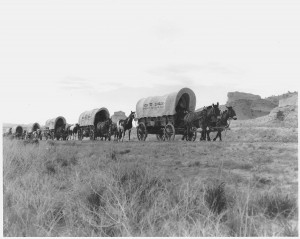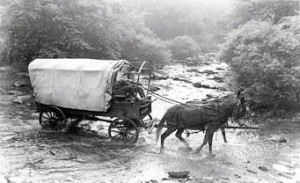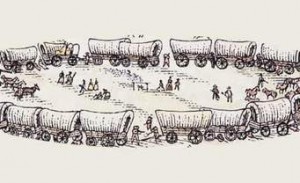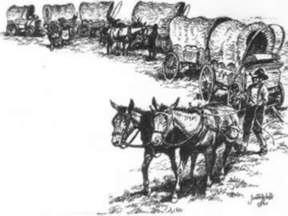
 It was inevitable really…the migration of the people of the United States to the west coast, in search of gold, adventure, and more land. The east was filling up, and there was no place else to go, but west. Of course, many people would either not make it all the way to the West; choosing rather to homestead along the way, die, or actually make it to the West, and then return to the East. Nevertheless, before anyone could find out is life on the west coast suited them or not, they had to get to the west coast, and on May 16, 1842, the first major wagon train to the northwest departed from Elm Grove. Missouri, on the Oregon Trail. This was a little bit of a risky move, because US sovereignty over the Oregon Territory was not clearly established until 1846.
It was inevitable really…the migration of the people of the United States to the west coast, in search of gold, adventure, and more land. The east was filling up, and there was no place else to go, but west. Of course, many people would either not make it all the way to the West; choosing rather to homestead along the way, die, or actually make it to the West, and then return to the East. Nevertheless, before anyone could find out is life on the west coast suited them or not, they had to get to the west coast, and on May 16, 1842, the first major wagon train to the northwest departed from Elm Grove. Missouri, on the Oregon Trail. This was a little bit of a risky move, because US sovereignty over the Oregon Territory was not clearly established until 1846.
Nevertheless, American fur trappers and missionary groups had been living in the region for decades, along with Indians who had settled the land centuries earlier. Of course, everyone out there had a story to tell, and there were dozens of books and lectures that proclaimed Oregon’s agricultural potential. You can’t tell a story without creating interest somewhere. Even a boring story is of interest to someone, and this was no boring story. With the books and lectures coming out of the West, the white American farmers were very interested. They saw a chance to make their fortune, or at least to become independent. The actual first overland immigrants to Oregon, intended to farm primarily. A small band of 70 pioneers left Independence, Missouri in 1841. The stories they had heard from the fur traders brought them along the same route the traders had blazed, taking them west along the Platte River through the Rocky Mountains via the easy South Pass in Wyoming and then northwest to the Columbia River…basically through some on my own stomping grounds. Eventually, the trail they took was renamed by the pioneers, who called it the Oregon Trail.
The migration, once started, had little chance of being stopped, and in 1842, a slightly larger group of 100 pioneers made the 2,000-mile journey to Oregon. With the success of these two groups, the inevitable happened, accelerated in a major way by the severe depression in the Midwest, combined with a flood of propaganda from fur traders, missionaries, and government officials extolling the virtues of the land. They may have had good intentions, but it is never a good idea to lie to the public. With the disinformation on their minds, farmers dissatisfied with their prospects in Ohio, Illinois, Kentucky, and Tennessee, hoped to find better lives in the supposed paradise of Oregon. With that another type of “rush” began. Much like the “gold rush” years, the farmers saw the land as their “gold” and headed west.
So, on this day in 1843, approximately 1,000 men, women, and children climbed aboard their wagons and steered their horses west out of the small town of Elm Grove, Missouri. It was the first real wagon train, comprised of more than 100 wagons with a herd of 5,000 oxen and cattle trailing behind. The train was led by Dr Elijah White, a Presbyterian missionary who had made the trip the year before. At first the trail was fairly easy, traveling over the flat lands of the Great Plains. There weren’t many obstacles in that area, and few river crossings, some of which could be dangerous for wagons. The bigger risk in the early days was the danger of Indian attacks, but they were still few and far between…at first anyway. The wagons were drawn into a circle at night to give the pioneers better protection from any attack that might come. They were very afraid of the Indians, who were enough different that they seemed deadly…to the pioneers anyway, and the Indians fear the White Man because of their weapons, and they were angry because the White Man wanted the land. In reality, the pioneers were far more in danger from seemingly mundane causes, like the accidental discharge of firearms, falling off mules or horses, drowning in river crossings, and disease. The trail became much more difficult, with steep ascents and descents over rocky terrain, after the train entered the mountains. The pioneers risked injury from overturned and runaway wagons.
Nevertheless, the wagon trains persevered, and the migrant movement continued until the West was populated. As for the 1,000-person party that made that original journey way back in 1843…the vast majority survived to reach their destination in the fertile, well-watered land of western Oregon. The next migration, in 
 1844 was smaller than that of the previous season, but in 1845 it jumped to nearly 3,000. Migration to the West was here to stay and the trains became an annual event, although the practice of traveling in giant convoys of wagons soon changed to many smaller bands of one or two-dozen wagons. The wagon trains really became a thing of the past in 1884, when the Union Pacific constructed a railway along the route.
1844 was smaller than that of the previous season, but in 1845 it jumped to nearly 3,000. Migration to the West was here to stay and the trains became an annual event, although the practice of traveling in giant convoys of wagons soon changed to many smaller bands of one or two-dozen wagons. The wagon trains really became a thing of the past in 1884, when the Union Pacific constructed a railway along the route.


One Response to First Oregon Trail Wagon Train